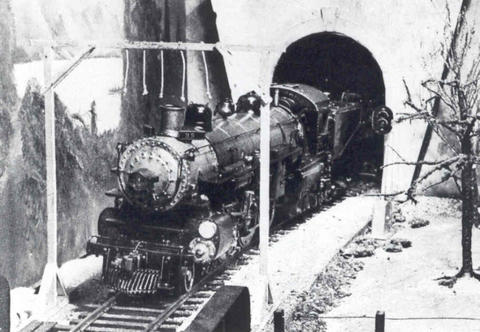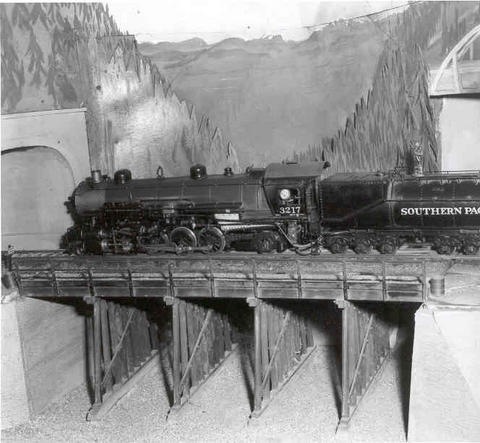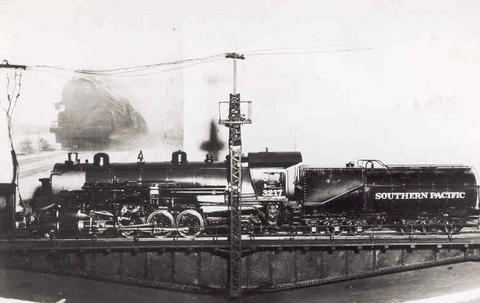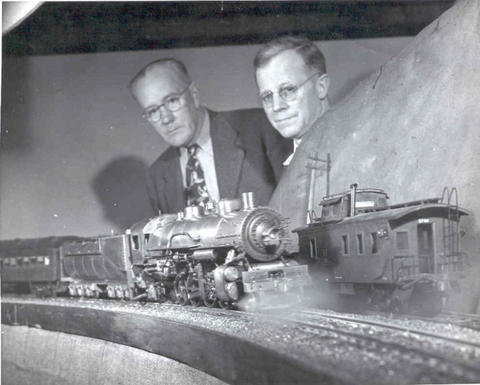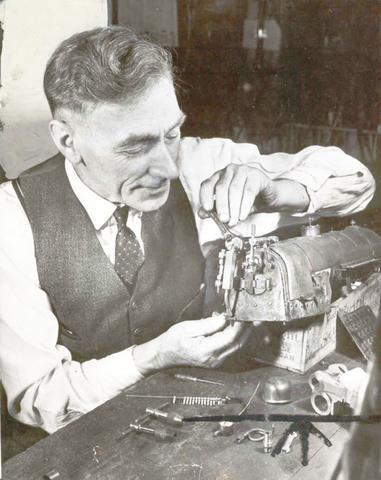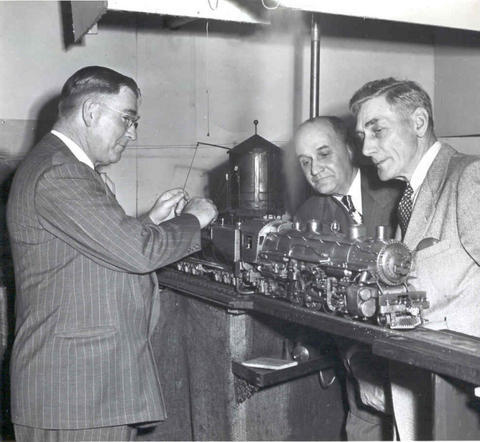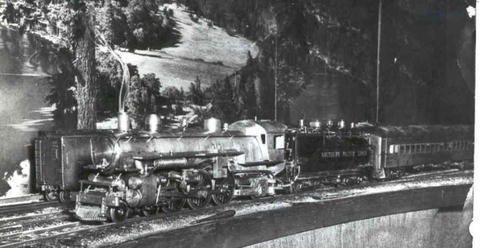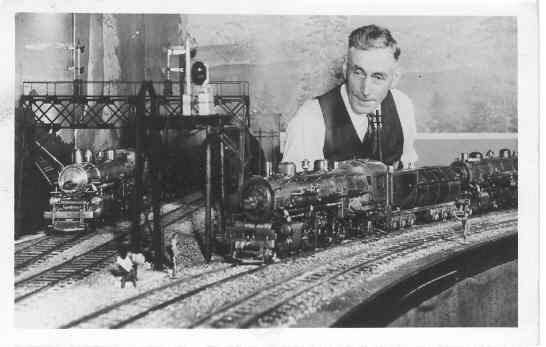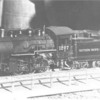Thanks for your replies guys ! Here is some general info about Vic Shattock's Live Steam basement railroad ...
VICTOR SHATTOCK’s BASEMENT RAILROAD
Oakland, California
** FACT SHEET **
Location: 1877- 38th Avenue, corner of Foothill Blvd; Fruitvale District—Oakland…
Total trackage: Approx. 400 feet.
Scale and Track Gauge: ½ inch scale; 1/24th full size; 2 ½ inch gauge.
(Known in the United Kingdom officially as "Gauge Three")
Fuel: Denatured Alcohol (wood alcohol)
(Known in the United Kingdom officially as "Methylated Spirits")
Burner Method: Vaporizing Burner of Vic Shattock’s personal design.
Boiler construction: Standard fire-tube boiler construction (all copper) using staybolts
Asbestos boiler lagging, and other accessories.
Boiler pressure (operating): 85 to 100 psi …
Feed Water: Axle-driven pumps; Horizontal feed water pump, steam operated.
Lubrication: Steam cylinder oil via Mechanical Lubricator
Direction of travel: Standard johnson bar in the cab on engineer’s side.
Throttle control: Manual… Throttle handle extended just a little thru the cab roof.
Radio Control: NO… Not available…
Locomotives:
TWO (2) 2-8-2 "Mikados" : # 3217 and # 3254
TWO (2) 4-6-2 "Pacifics" : # 2422 I and # 2422 II (# I built in 1929)
ONE (1) 2-8-0 "Consolidation" # 2753
ONE (1) 0-6-0 "SP Switch Engine" # 1207 (Stolen from basement in 1946)
Rolling Stock:
Twenty-two (22) freight cars of various types.
One (1) Central Pacific "Harriman-style" Chair Car (coach)
One Turntable: SP 110-foot common standard (55 inches long) containing 2500 rivets.
Three tunnels
One ballast deck trestle
One steel girder bridge
Two signal bridges
Three two-track stub end yards
Twelve turnouts plus One double-slip switch
Roundhouse with Five(5) stalls and electrically operated turntable.
One water column standpipe (operational)
One water tank with spout in Roundhouse (operational)
Fully automatic block signal system
Overall interior size of basement: 45 x 32 feet-- 9 foot ceiling...
110-lb, SP Common Standard T-rail (BRASS) specially created and rolled by Rollin J. Lobaugh Company. They also provided scale rail joiners, spikes, and tie plates: All brass.
Wood for ties and car bodies came from old Kraft Cheese Boxes and cut to desired pieces.. (LOTS)
Tanks for "tank cars" came from former Carbon Tetrachloride fire extinquisher bottles.
Ice cubes could be fed through hatches of two PFE cars and keep your sandwich cold while working on the layout. SP Hopper car had all working doors and was used for ballasting the track.
To SEE this layout in operation, go to You Tube and Search for "Steam Railroading in the Basement" ... There are two parts! Among the dozens of newspapers and magazines my Grandfather was featured in, he was on the front cover of Model Railroader for APRIL-1951 and JANUARY-1939... In the Jan-'39 issue is a photo story written by "Boomer Pete" (Al Kalmbach) who visited and couldn't believe what he saw firsthand!
Notable Guests and other visitors:
Various Southern Pacific Officers
Various Southern Pacific Division Managers
Al Kalmbach, Publisher, Model Railroader
Linn Westcott, Editor, Model Railroader
Bill Walthers, The Walthers Company
John Allen, Gorre & Daphetid RR, Monterey, CA.
Eddie "Rochester" Anderson (Jack Benny Show)
Walt Disney
Dick Bagley, Publisher, The Miniature Locomotive
Whit Towers, Editor, NMRA Bulletin
Bob Bast, NMRA
Lawrence Sagle, B&O RR
Various civic, school district, and other community leaders
News Media (various)
Movietone News
Lloyd Combs, Professional film maker…
Ray Maker, Amusement Park Train builder
Billy Jones, Los Gatos
Louis McDermott, Overfair Railway builder
Charles "Budge" Garbett, local oldtime modelmaker
Rollin J. Lobaugh, Model Railroad Manufacturer
Jack Collier, Jack Collier’s "Toys for Men", Oakland.
Walter I. Brown, founding member, Eastbay Model Engineers Society
Plus hundreds and hundreds of other visitors.
All railroad locomotives, rolling stock and accessories totally "scratchbuilt" from raw
materials in Victor Shattock’s workshop… No kits of any kind were used…
Notable Events:
Founding location and Headquarters: Golden Gate Live Steamers (1936)
National Convention Layout Tour (NMRA)-- Oakland, CA. (1947)
Radio Appearance: The Old Craftsman, KFRC, San Francisco (1938)
Radio Appearance: Hobby Lobby, New York City (1938)
In the 1940’s , Victor Shattock and his friend and fellow club member, Walter Brown,
were National Co-Chairmen of the NMRA’s "Live Steam Standards Committee" …
Victor Shattock was employed by the Southern Pacific Railroad for thirty-six years !
(1923—1959)
Within the railroad’s maintenance of way department (Western Division) he was the "Water Service Foreman" (railroad plumbing//HVAC) , responsible for anything on the railroad having to do with plumbing, HVAC, tinsmithing, train and ferryboat fueling, and so forth.
He was a member of the Brotherhood of Maintenance-of-Way Employees (BMWE) and was Secretary—Treasurer of Subordinate Lodge # 407 at West Oakland. He was also Division Grievance Chairman and Asst.Chairman of the Pacific Federation.
I hope these facts about Victor T. Shattock are helpful in some way.
He died in Alameda, CA in April-1974 at the age of eighty-seven years…
Cheers...
KRK







